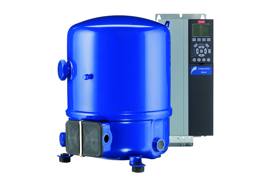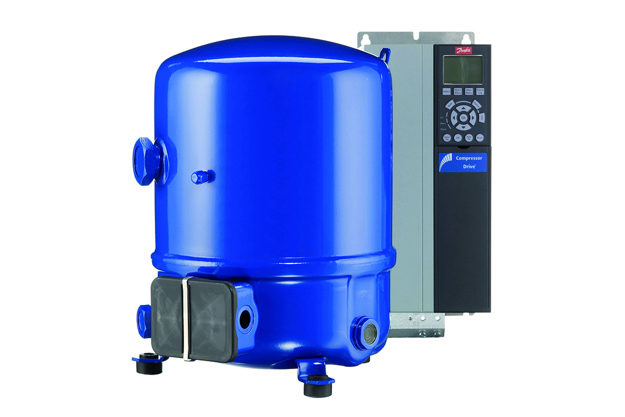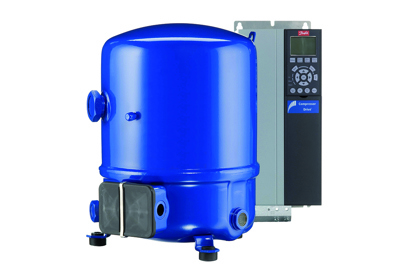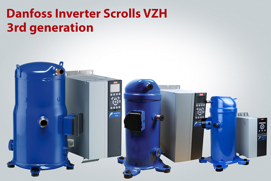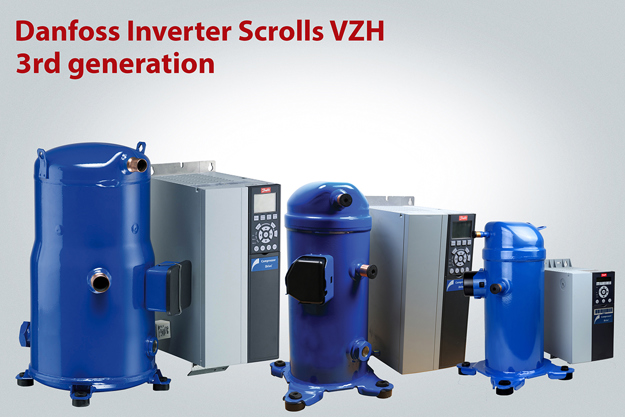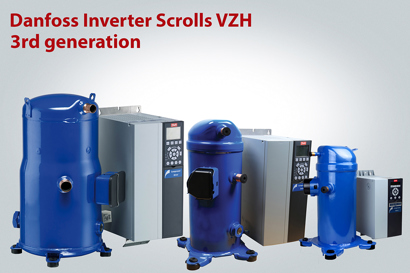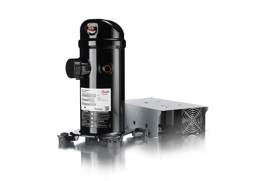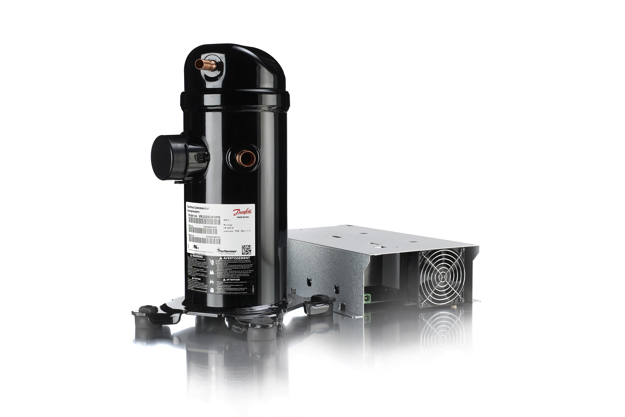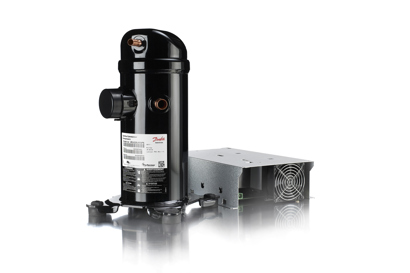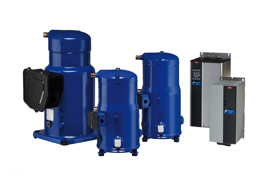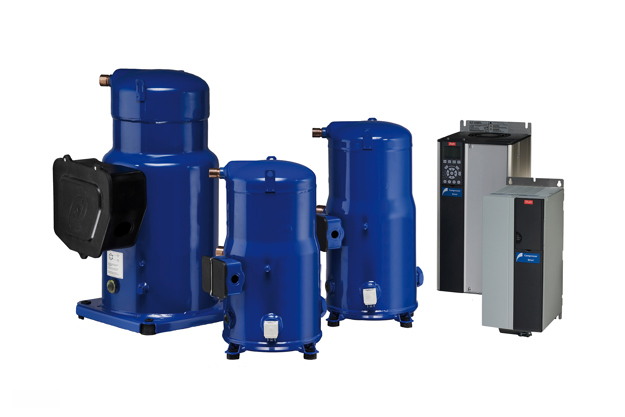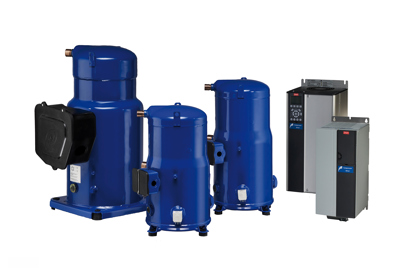Humidity control and greater comfort with
Application description
Variable Refrigerant Volume or Variable Refrigerant Flow (depending on the manufacturer) has been established since the early 1990s. The basic idea is that a large outdoor unit (or several manifolded outdoor units) serves multiple indoor units. Each indoor unit uses an expansion valve to control its refrigerant supply to match the cooling / heating demand of the space it serves. The outdoor unit also varies its output to match the total demand of the indoor units.
At any point during system operation there will be a variable volume of refrigerant flowing. Various strategies are used to respond to changes in the cooling or heating requirements including:
- Modulating fan(s)
- Variable speed inverter drive compressor(s)
- Multiple compressors of varying capacity
- Single or multiple modular outdoor units
- Outdoor unit capacities range from around 10 kW to 180 kW.
System types
VRF systems can be used for cooling only, heating and heat recovery. In heat pump models, the indoor units can be operated in either mode, but must all be in the same mode if served by the same outdoor unit. The cooling only and heat pump models are effectively large, sophisticated, multi-split units. The heat recovery or simultaneous mode systems provide both heating and cooling from the same outdoor unit and can therefore exploit this technology more effectively, offering considerable potential for energy savings.
Why is the VRF system so popular?
With rising energy prices and requirements to improve general building services in medium to large buildings, VRF systems offer not only high energy efficiency but also great comfort with precise temperature and humidity control, as well as flexibility in modulating individual indoor units to provide the desired cooling / heating in each room. By modulating the amount of refrigerant being sent to each indoor unit, VRF systems can save up to 40% energy over comparable unitary equipment. An air source VRF system is engineered to minimize piping work and save multiple water pumps and water piping.
Why choose Danfoss inverter compressors for VRF?
Different technologies are applied in the market today to modulate cooling/heating capacity. DC inverter technology is acknowledged as the trend for compressors, since it provides the required modulation and the greatest energy savings.
By using the Danfoss inverter compressor – a reliable compressor combined with a prequalified drive – the objectives for capacity modulation and energy savings can be met for systems ranging from 10 to 26TR (full speed for a single compressor – ARI conditions).
The Danfoss inverter compressor solution for commercial HVAC applications allows a VRF system to modulate the cooling capacity precisely between 25% and 100% when a single compressor is used, and between 12.5% and 100% with tandem compressors (Modulation range for VZH compressors). The unit adjusts to the varying loads that the building needs during the day.
- One of the main benefits of using Danfoss inverter compressors for this application lies in their simplicity and reliability. With its large capacity, the Danfoss VZH inverter compressor can reduce the number of compressors installed in one outdoor unit to one (14-26HP). This makes the system design simple as well as leads to higher reliability.
- The second benefit is the energy savings obtained. The Danfoss inverter compressor solution provides significant improvements in seasonal energy efficiency. This Danfoss solution can create annual energy savings ranging between 10% and 30% when compared to traditional HVAC equipment in the current market, depending on the load profile and the climate. And the inverter compressor capacity modulation will accommodate the varying loads in the system.
- Another important benefit is the compactness of the unit. The compact unit design reduces both transportation costs and the footprint for the system as a whole.
What are the benefits for end users when OEMs choose Danfoss inverter compressors?
Seasonal energy efficiency: the unit copes effectively with changes in temperature
- Partial load operation increases efficiency
- Capacity modulation: adaptation to widely varying cooling loads
- Increased comfort with stable indoor air temperature and precise air temperature control
- Better humidity control
- Less noise than with conventional on-off systems during partial load operations, and in particular at night
- Lower environmental impact with R410A refrigerant
- Start-up current requirement is low
- Reduced applied costs are possible thanks to the Danfoss VZH inverter range.
The most important benefit for customers
- Top comfort with cost savings
Additional benefits
- Innovation and development of new technologies made possible
- Increased market share achievable through more innovative products
- Greater opportunities to expand and grow.
Highlighted products
-
if (isSmallPicture) {


 Reciprocating inverter - VTZ
Reciprocating inverter - VTZDanfoss reciprocating inverter compressors avoid oversized and short cycling systems. The compressor automatically adapts to the current load. By combining an efficient Danfoss Maneurop® reciprocating compressor with a Danfoss Drive, the company provides an innovative and intelligent package that utilizes variable-speed technology to ensure superior efficiency across the entire operating range for precision cooling.
-
if (isSmallPicture) {


 Inverter scrolls - VZH
Inverter scrolls - VZHDanfoss inverter scroll compressor VZH offers effectiveness and reliability. Over 30% energy savings is possible in rooftops, chillers, close controls etc.
-
if (isSmallPicture) {


 Inverter scrolls - VRJ
Inverter scrolls - VRJDanfoss inverter scroll compressor solutions for commercial air conditioning and process-cooling applications. R410A, single units. VSH: first-generation commercial inverter scroll compressors with frequency converter CDS302. VZH: second-generation commercial inverter scroll compressors with frequency converter CDS303. VRJ: first high-tier residential inverter scroll compressors with frequency converter CDS801.
-
if (isSmallPicture) {


 Inverter scrolls - VSH
Inverter scrolls - VSHDanfoss inverter scroll compressor solutions for commercial air conditioning and process-cooling applications. R410A, single units. VSH: first-generation commercial inverter scroll compressors with frequency converter CDS302. VZH: second-generation commercial inverter scroll compressors with frequency converter CDS303. VRJ: first high-tier residential inverter scroll compressors with frequency converter CDS801.
Contact us
For further information, please contact us.

